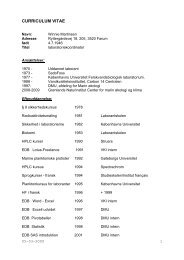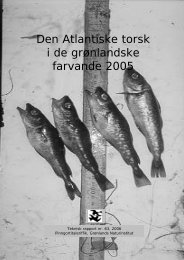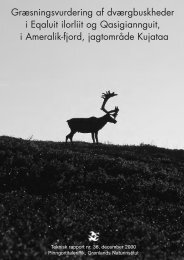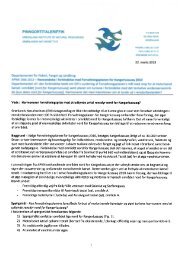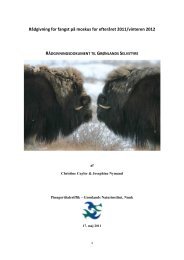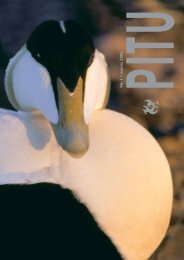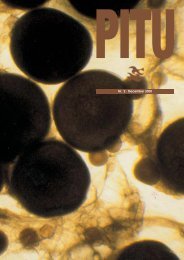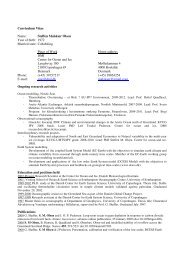Migration and breeding biology of Arctic terns in Greenland
Migration and breeding biology of Arctic terns in Greenland
Migration and breeding biology of Arctic terns in Greenland
Create successful ePaper yourself
Turn your PDF publications into a flip-book with our unique Google optimized e-Paper software.
Figure 1. Daily survival rates <strong>in</strong><br />
relation to age <strong>and</strong> hatch order for<br />
a <strong>breed<strong>in</strong>g</strong> attempt <strong>in</strong>itiated at the<br />
average day <strong>of</strong> fi rst clutch <strong>in</strong>itiation<br />
(day 34). Age is expressed <strong>in</strong><br />
days to or from hatch<strong>in</strong>g (where<br />
day zero is the hatch<strong>in</strong>g date).<br />
The black l<strong>in</strong>e represents the survival<br />
rate <strong>of</strong> eggs <strong>and</strong> the A-chick,<br />
<strong>and</strong> the grey l<strong>in</strong>e the survival rate<br />
<strong>of</strong> the B-chick.<br />
48<br />
Results<br />
Model <strong>in</strong>put<br />
The average clutch size at Kitsissunnguit <strong>in</strong> 2002-2006 equalled 1.84<br />
(± 0.012, n = 1752) expressed as a 0.921 (95% CI 0.850-0.960) probability <strong>of</strong> a<br />
two egg clutch <strong>in</strong> fi rst nest<strong>in</strong>g attempt. Clutch size (1.6 eggs, ± 0.13, n = 16)<br />
<strong>in</strong> replacement nests was signifi cantly lower (χ2 = 16.8, p = 0.0002, df = 2)<br />
than non-manipulated nests (2.04 ± 0.026, n = 367) <strong>in</strong> 2006 <strong>and</strong> expressed<br />
as a probability <strong>of</strong> 0.654 (95 % CI 0.483-0.792) <strong>in</strong> the model. Daily nest survival<br />
(egg harvest excluded) varied over the course <strong>of</strong> the <strong>breed<strong>in</strong>g</strong> season,<br />
<strong>and</strong> daily chick survival varied with chick age (slope 0.067 ± 0.021,<br />
p = 0.0013) <strong>and</strong> with hatch<strong>in</strong>g order (Fig. 1). Egg <strong>in</strong>viablity probability was<br />
estimated to 0.035 (95 % CI 0.020-0.058).<br />
Daily survival rate<br />
1.02<br />
1.00<br />
0.98<br />
0.96<br />
0.94<br />
0.92<br />
0.90<br />
0.88<br />
The <strong>in</strong>cubation period was set to 22 days <strong>and</strong> the period from hatch<strong>in</strong>g to<br />
fl edg<strong>in</strong>g to 27 days (Cramp 1985, Hatch 2002) whereas the replacement<br />
period (period between a nest is harvested <strong>and</strong> a replacement nest produced)<br />
was set to 9.5 days (± 0.23, n=16).<br />
The population estimates for Kitsissunnguit based on transects varied between<br />
15,354 <strong>and</strong> 21,760 pairs (Egevang <strong>and</strong> Frederiksen 2010) with an<br />
average <strong>of</strong> 18,465 (± 1,023) pairs used <strong>in</strong> the simulation model. The l<strong>and</strong><br />
area (Basisø) exposed to harvest<strong>in</strong>g equals 38.0 % (3.21 vs. total <strong>of</strong> 8.43<br />
km 2 ) <strong>of</strong> the total l<strong>and</strong> area whereas 80.4 % (14,845 ± 1,136) <strong>of</strong> the total Kitsissunnguit<br />
population numbers (average 2002-2006) is found at Basisø.<br />
The l<strong>in</strong>e transect also produced estimates <strong>of</strong> nest encounter probability,<br />
which can be used as an expression <strong>of</strong> harvest effi ciency as search for nests<br />
<strong>in</strong> the two situations resemble each other. In 2004, 555 m<strong>in</strong>utes <strong>of</strong> effective<br />
search<strong>in</strong>g over 6,360 meters <strong>of</strong> l<strong>in</strong>e resulted <strong>in</strong> 415 found eggs orig<strong>in</strong>at<strong>in</strong>g<br />
from 234 nests. These results were used to calculate a probability that an<br />
<strong>in</strong>dividual nest was encountered person hour -1 : 234 [nests found] / (9.25<br />
[hours search time] × 18,465 [nests, total] ) = 0.001370<br />
Model output<br />
0.86<br />
–30 –25 –20 –15 –10 –5 0 5 10 15 20 25 30<br />
Nest age (days from hatch<strong>in</strong>g)<br />
Model output consisted <strong>of</strong> predicted harvest size (number <strong>of</strong> eggs harvested)<br />
<strong>and</strong> productivity (number <strong>of</strong> chicks fl edg<strong>in</strong>g per nest) under various<br />
harvest scenarios (Figs 2 <strong>and</strong> 3, A <strong>and</strong> B). An Harvest-Impact Ratio (HIR)<br />
is presented <strong>in</strong> Figure 2 C <strong>and</strong> Figure 3 C, <strong>and</strong> was calculated as:<br />
(HIR = Nh/(P0-Ph)),





